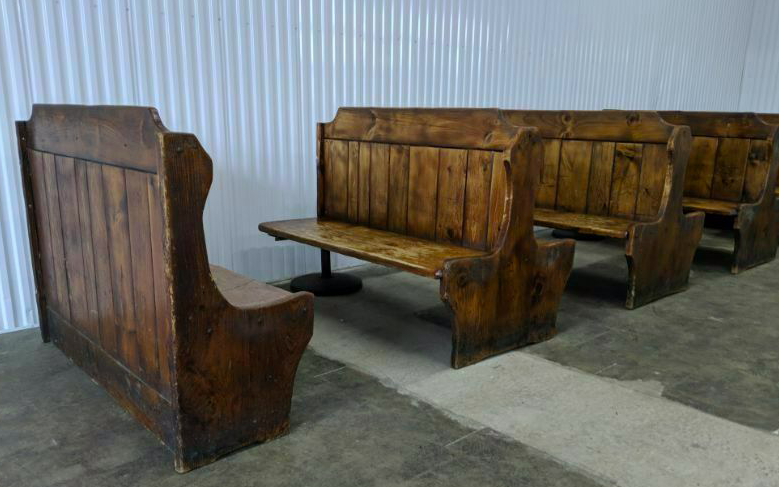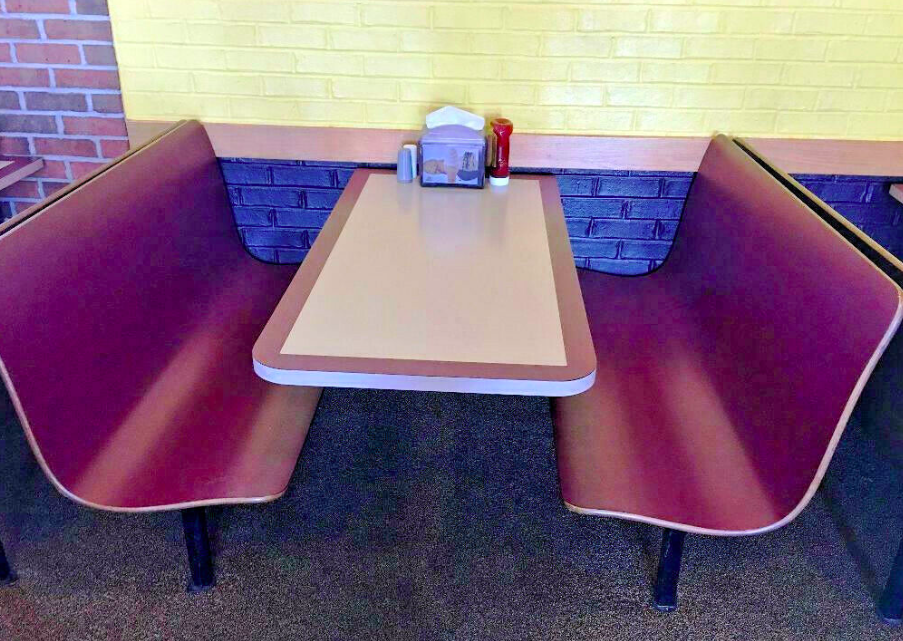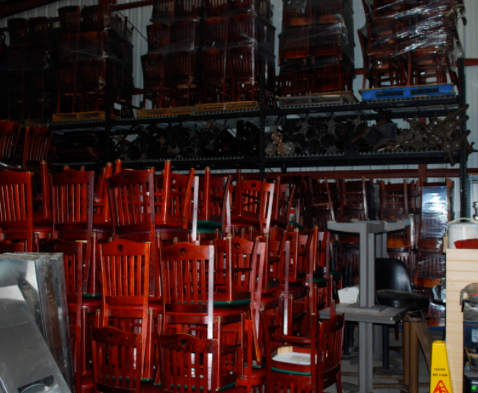For many restauranteurs and business owners, the chairs in the dining room end up being a bit of an afterthought. Many buyers tend to focus more on the quality of the equipment in the kitchen itself, instead of the furniture in the dining room. But choosing the right used restaurant booths and chairs is a critical part of the interior design of any commercial establishment.
Browse our active listings of used commercial booths and chairs below. Why pay full price for this equipment when you can save money without compromising quality? Check out our full inventory of used restaurant equipment here.
[display_listings l_type=”103″]
Introduction

In any successful restaurant, deli, diner, or convenience store, there are dozens of legs hitting the floor of your dining room at any given moment. No, we’re not talking about the hordes of hungry customers anxiously awaiting your latest kitchen creations; we’re talking about the legs of the chairs getting dragged across your pristine floors morning, noon, and night.
The restaurant booths and chairs you choose for your dining room can make an enormous impression on both the atmosphere of your establishment, and the overall comfort of your customers. A gorgeous, meticulously-designed restaurant interior that’s filled with cheap, plastic promotional furniture with Coca-Cola logos all over it, or badly-made residential-grade furniture from a big box store will be a big turnoff for customers, and put you at risk for repair or replacement quickly.
The problem is this: As you start to figure out just how many used restaurant booths and chairs you’re going to need to fill your space, you’ll see that the bill starts to add up rather quickly. Restaurant booths and chairs are usually sold singly or in bundles; at $100 and up per chair, it’s easy to rack up a huge invoice, even if your establishment only seats 30 people at a time.
The good news is that options for used restaurant booths and chairs are widely available, plentiful, and a great place to start cutting costs in your restaurant’s interior design budget…if you know how to shop smart. Because they’re designed to withstand years of heavy use in a commercial environment, many used restaurant booths and chairs can be brought back to showroom condition with just a good cleaning and a few do-it-yourself repairs. Before deciding on which restaurant booths and chairs to go with, here are some additional tips to consider.
What to Look For When Planning a Purchase of Used Restaurant Booths and Chairs

Figure out what style of booths and chairs are right for you and your business. The style of chair or booth you choose for your dining room can tell your customers a lot about your business.
Wood materials (either rustic, reclaimed versions or more refined, antique-style pieces) can express a feeling of coziness and warmth, while metal chairs can feel cold and make a lot of noise as they are moved around in the dining room. Consider chairs and booths that combine both materials, which creates an interesting look while maintaining the benefits of each.
Consider the comfort and size of your chairs. Restaurant chairs and booths come in an almost unlimited array of shapes and sizes. Pay particular attention to the height of the seat and back. Seats are typically 16, 18, or 20 inches wide.
The seat width that’s right for your business depends a lot on the type of establishment you own; cafes and quickservice restaurants tend to choose smaller seats, where comfort is less of a consideration and tables turn over quickly. Fine dining restaurants use wider seats, to maximize the comfort of guests who will usually stay longer and for whom comfort is a priority.
The back height of the chairs you choose is important as well, but more for design reasons than functional ones. When designing an interior, choosing furniture and decor with varying heights creates more visual interest in the space; look for chairs with backs higher than 30″, since these will sit above the height of the tables and create a more substantial look for your dining area.
Don’t be tempted to buy consumer or residential-grade chairs. Look, we get it; dropping tens of thousands of dollars on chairs can be brutal. Sooner or later, most of us consider chucking the idea of buying furniture designed for commercial use, can wonder if we can get by with using alternatives from a a big box store, Internet retailer, or furniture chain.
The temptation can be great; chairs designed for residential use can often be purchased in 4-or-6-packs at bargain prices, and many appear aesthetically similar to commercial-grade seating. But use caution: That furniture set from Target probably is going to end up costing you more money in the long run.
First, the joinery is often not designed for constant, repeated use. Second, the finish is often residential grade, and usually won’t hold up to the raw cleaning power of commercial-grade cleaning products.
But perhaps most importantly, the manufacturer has not tested the product for commercial use. This means that if a noncommercial chair is used in a commercial environment, and the chair fails (which is a fancy way of saying (“collapses out from under one of your customers”), the manufacturer will have limited liability in the claim and you will be 100% financially responsible.

Consider how important your seating is to the function and atmosphere of your restaurant. Remember, restaurants aren’t just a place that serves our biological need to feed our bodies with fuel; they’re also a place to relax, unwind, and ultimately have some kind of experience.
Choosing which of these is more critical to your business is an important step in choosing used restaurant booths and furniture. Are your customers popping in, grabbing a quick bite, and leaving? This makes interior design choices somewhat less important.
However, if you’re trying to create a destination or an experience for your guests, you’ll need to evaluate the role your restaurant booths and chairs play in creating the atmosphere you want.
Consider your flooring. Just as important as the chairs themselves, is the material your new furniture will be sitting on. Whether your dining area features wood floors, carpet, or tile, each surface will require a chair with different characteristics to perform at its best. Think of the interplay between your shoes and your feet.
If you’re wearing the wrong shoes for the task you’re performing, you’ll feel the negative effects in your legs, hips, and knees. Similarly, a chair that’s not well suited for the surface it’s sitting on will cause discomfort, uncomfortable vibration that can ultimately cause chair joints to fail, and excessive noise in your dining room.
If your dining room features wood floors, you’ll need to consider adding felt glides to the bottoms of chair legs, to prevent damage to both the floors and the chairs themselves. These will wear out quickly and need to be replaced often, but will cut down drastically on damage to the furniture, the floors, and noise. Chairs on carpet perform best if a nickel-plated glide is used. They will slide better than plastic options.
Dining areas with tile floors have a few different options for keeping chairs sliding freely, including plastic or nylon, which wears harder and generally performs better in the long run.

Understand your budget limitations. Begin by counting how many seats you need to include in your dining area, then divide by how much money you have to spend to give you a ballpark estimate of what you can afford to spend per chair.
Once you have this number in mind, you can then determine if you will need to consider cheaper furniture, or if you can add additional pieces.
